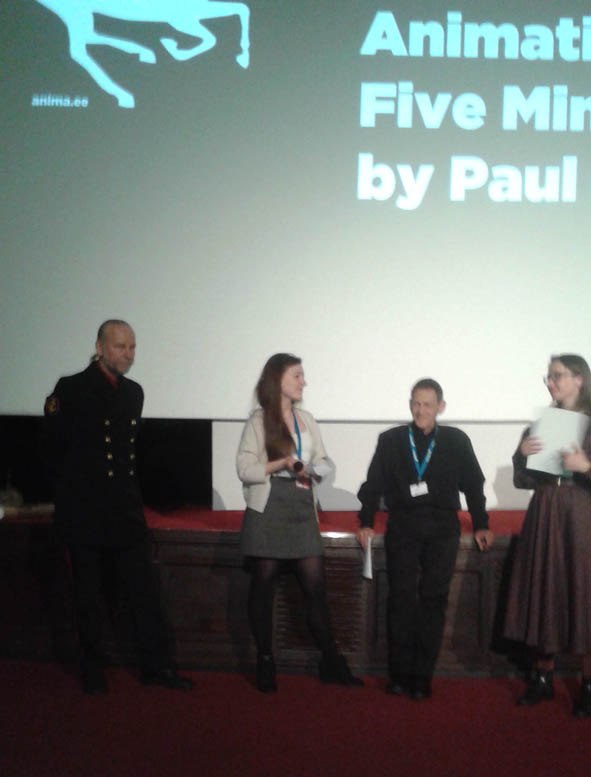Estonians are natural story tellers and many of their films are metaphoric stories about very human problems. If you take the time and effort to dig deeper beyond the surface the stories are extremely layered.
 The first page of the Animated Dreams Festival catalogue proclaims “The universe is made up of stories, not atoms” and nowhere is that more true than in Estonia. Estonians are natural story tellers and many of their films are metaphoric stories about very human problems. If you take the time and effort to dig deeper beyond the surface the stories are extremely layered. I love Estonian animation but the films always make me work and they usually take at least two viewing to fully understand and appreciate them.
The first page of the Animated Dreams Festival catalogue proclaims “The universe is made up of stories, not atoms” and nowhere is that more true than in Estonia. Estonians are natural story tellers and many of their films are metaphoric stories about very human problems. If you take the time and effort to dig deeper beyond the surface the stories are extremely layered. I love Estonian animation but the films always make me work and they usually take at least two viewing to fully understand and appreciate them.
At the opening night ceremony we were welcomed into the theatre with shots of vodka and Fritz-Kola, which was a festival sponsor. The program was devoted to showcasing some of Estonia’s top animators. The evening opened with Kasper Jancis’ delightfully quirky Piano. The lives of Marta, who has just bought a piano from a local thrift shop and is trying to take it home by herself, Albert who has been trying to tell Paula that he loves her for thirty years, a policeman who dreams of parachuting, a truck driver, and Mirjam who dreams of tight rope walking all intersect as a bee makes an attempt to fly out of the window in Kasper’s 10 minute film.
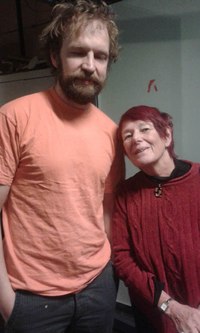 I have been a fan of Kasper’s quirky films for a long time but you have to see them more than once to catch all of the subtle details. Piano is no exception. There is even a short homage to Gone With the Wind on a television set. This is the first of his films that I can remember having a remotely happy ending even though at the end of the film two of the six characters are dead.
I have been a fan of Kasper’s quirky films for a long time but you have to see them more than once to catch all of the subtle details. Piano is no exception. There is even a short homage to Gone With the Wind on a television set. This is the first of his films that I can remember having a remotely happy ending even though at the end of the film two of the six characters are dead.
Ulo Pikkov is a master at puppet animation, but for Zebra and All the Curtains In My Life he drew directly on the film. Ulo describes the film as “In my dreams I often see a zebra. A huge zebra who runs behind the window. When there is a black stripe – night . . . A white stripe – day . . . And all my curtains are falling down.” After his explanation I need to see the six minute film again.
Urmas Joemees, Hardi Volmer, and Ulo Krigul take the viewer on a nine minute trip to 15 randomly visited cities worldwide in their film Urbanimatio. The film is a poetic portrayal of the evolution, devolution, aging, and constant regeneration of cities.
Animation Director Liis Viira is also an accomplished harpist and composer. Liis says that she sang before she could speak and soon after that she began drawing. As a child she watched Estonian animation paying special attention to the music. Liis said that “. . .coming to animation much later myself I found the genre of visual art closest to music.” At the opening night screening she accompanied her film Honey, I’m Coming on the harp. The film is an insect’s view of flowers and plants.

Animated Dreams, which is part of the Black Nights Film Festival, not only presents Estonian animation. For five days it brings the best animation from around the world to Tallinn. I had already seen most of the films in the International Competition at other festivals but I did see very interesting films in the strong Student Competition. The eight minute film About A Mother by Dina Velikoovskaya was very moving. The universal story of a mother who sacrifices everything to protect and care for her sons while they are little is a story that every mother can relate to. After her sons leave home, she is still always there when her sons need her. It is a simple story in 2D black and white and the line drawn images add a deeper dimension to the story.
Along with the competitions there were many special programs. Kalju Kivi is a revered name in Estonian animation and this year he was a member of the festival jury. The retrospective of his films gave the audience an opportunity to see a body of work by one of the principal contemporary experimenters in animation. The diverse materials that he uses are limitless: collages, cut-outs, string, fabric, puppets, glass, wood, pixilation; anything that he can get his hands on. Kalju really doesn’t like to repeat himself and is always on the outlook for new materials to experiment with.
The ten films in the program varied greatly in style and content. The 1985 cut out animation Glass Cluster Games is about ice and fire and the victory of the sun’s life giving warmth over icy nothingness. Ten years later Kivi used collage to create Humanchinoid. The six minute film is about a man who becomes a Humanchinoid because of society’s impact on him. The film has political undertones about the experience of being human in a complicated world defined by a totalitarian system at one pole and the consumer feast of rampant Capitalism on the other.
The screening ended with his 1988 fourteen minute pixilation Why the Trees Don’t Talk? The film was inspired by an Estonian folk tradition.
Belgian animator Emma de Swaef along with her partner Marc Roels made the remarkable animated film Oh Willy which won over eighty international awards. Emma was also on the International jury. Along with her jury duty she gave a workshop for students at the Estonian Academy of Arts Animation Department.
Israeli lecturer, journalist, film critic, and producer Tsvika Oren was the third member of the jury. Tsvika presented a selection of wonderful films which have not been seen at festivals for many years. The twelve films in the program took us through several decades and styles of animation. Jonas Odell, known primarily for his music videos and anima docs, looped scenes that range from a few seconds duration to around one minute each to create the eight minute Revolver. From a fish splashing in a small puddle of water on a boat deck to robots going about their domestic chores the repeating images are delightfully disturbing.
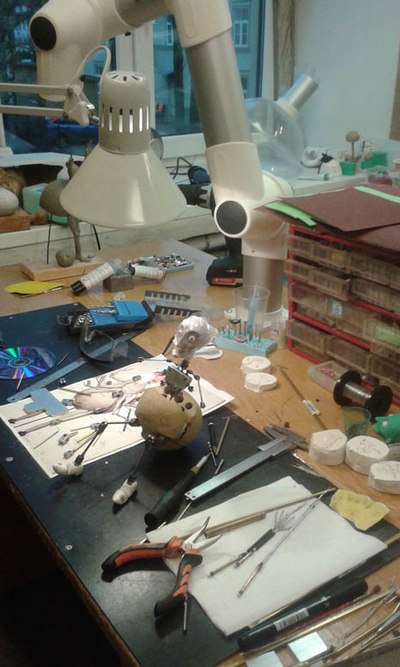
At the other extreme Sara Petty took us on a three minute fanciful, sensual romp in Furies as two Siamese cats playfully chase each other. The film is beautifully drawn in pastels and the cats cavort to a musical score composed by Ned Rorem. Tsvika put together a beautiful program of animated treasurers that definitely deserve to be seen on the big screen more often.
This year the festival spot light was on Georgia. This was a special treat for me because I have not seen a great deal of animation from that country. Animation in Georgia began in the 1920’s as cartoons made for Bolshevik propaganda. Georgia, like all of the other Soviet republics, suffered severe repression which hampered the creation of animation until the 1950’s and 60’s when animation took a big leap forward. By the end of the 1960’s the first professional animators graduated from the Film Institute in Moscow (VGIK) and returned to Georgia.
Today animation is alive and active in Georgia as the program presented by Georgian animator Mariam Kandelaki proved. I was particularly impressed by two films by David Takaishvili. Plague, a nine minute film, is about one color that becomes powerful and annihilates all of the other colors but finally it perishes in its own color world. The lovely painted on cel film won the Best Short Film at the 1984 Cannes International Film Festival.
The Raven (1981) by Takaishvili is equally stunning to look at. The twelve minute film which is painted in oil on cels is a tale about evil which destroys everything around it and as a result eventually destroys itself.
Franziska Bruckner, Stefan Stratil, and Thomas Renoldner of ASIFA Austria have curated a DVD to celebrate the 30th Anniversary of the founding of ASIFA Austria. There is almost no animation industry in Austria except for a small advertising and gaming industry but there is a very active independent scene of creative animators who work primarily on experimental films as the two programs presented by Bruckner and Stratil showed. The first program Visions of Animation showcased contemporary figurative and narrative animation, most of it falling into the fine arts category. The second screening Ways To Abstraction contained an overview of different forms of Austrian abstract animation.
Along with screenings for children and feature films there was also a daily Directors Chat which gave the audience the opportunity to meet the animators up close and personal and ask questions about what motivated them to create their film or the techniques that they used.
A highlight of my trip to Tallinn was my visit to Nukafilm. The studio dates back to 1957 and is located in an old Soviet sock factory. The renowned puppet animation studio is home to such giants of animation as Riho Unit, Hardi Volmer, Kasper Janics, Mati Kutt, Priit Tender, Rao Heidmets, and Ulo Pikkov to name just a few of the award winning artists who call Nukafilm home.
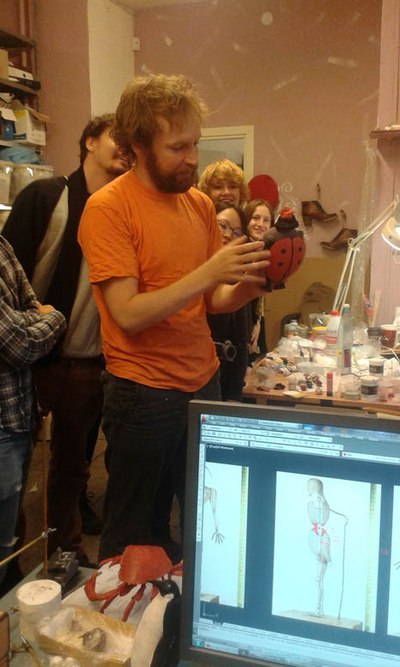
Riho Unit’s The Master, based on a well-known Estonian book, is a damning indictment of society’s class system. The beautifully crafted puppet animation won the Special Jury Crystal at Annecy last year. Riho also made my very favorite puppet animation film, the 2005 Brothers Bearheart, a fantasy based on a real painting by the well-known Russian artist Ivan Shishkin. The heroes of the film are the three bear cubs from Shishkin’s painting Morning In A Pine Forest which I have seen in the Pushkin Museum in Moscow. In the film the three bear brothers Henry, Vincent, and August go to Paris to create art after their painter mother is shot by Shishkin, who then signs him name to the their mother’s famous painting Morning In A Pine Forest. Unfortunately the City of Lights isn’t ready for the three young bear impressionist artists, so they decide to travel back to Russia to unmask Shishkin, who after signing his name to their mother’s painting, has become the toast of Moscow.
Nukufilms was busy, with Kasper Janics and his crew hard at work on his first puppet feature film. Morton is based on a children’s book which Kasper wrote. Morton is a curious and inventive boy. Unfortunately fate has forced him to live with foster parents who see his creative endeavors as malicious hooliganism. The film is an Estonian-Irish co-production and judging from the puppets and sets that I saw at Nukufilm it will be a very lovely film. Morton is due to be released in 2017 and I am looking forward to seeing it.
In another part of the building Ulo Pikkov was shooting his new puppet film An Empty Space. The film is based on a true story of a father who hides in the basement of his house for ten years during the Soviet occupation. While in hiding he carves a doll house for his young daughter that is an exact replica of his home upstairs, down to the teapot and dishes in the kitchen cupboard. The real doll house is in a museum in Tallinn but it has been loaned to Ulo for use in his film. An Empty Space is due for release in 2017.
This year a two day Baltic Animation Forum focusing on the Baltic States Animation Industry was held concurrent to the Animated Dreams Festival. Along with studio presentations, BLON (Baltis Sea and Nordic Region Animation and Video Games Festival) introduced the festival’s aims and agenda. BLON was held 18 – 21 February 2016 in Klainpeda, Lithuania. Visit their new website, ANIMACLOUDY. It is the first European online one stop shop for animation and visual graphics with an eye to connecting the animation industry with the general film community.
The second day of the conference was devoted to the first ever indie developers’ conference held in Tallinn. The aim is to promote independent game developers and provide existing studios with tips and tricks for survival in a very competitive industry. Ulrich Wegenast, programmer of the Stuttgart International Animation Festival, was the special guest lecturer.
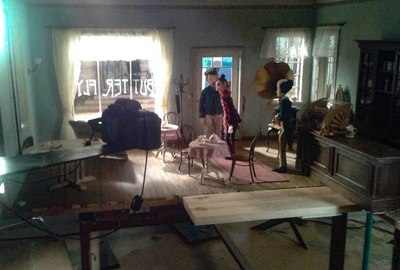
Evenings were packed with screenings and special events. One evening was Silent Movie Night. Conductor and composer Arash Yazdani put together a group of visual artists to create images that his ensemble performed live music to. Some of the pieces worked very well but several others gave me the feeling that the ensemble was playing without having previewed the images on the screen. Iranian born Arash is currently perusing a PhD in research of composition at the Estonian Academy of Music and Theatre.
The Late Night Love Club was an adult program of animation about love, relationships, lust and sex. On another evening the Late Night Comedy Club pushed laughter to the very limits of hilarity with an occasional leap over the bounds of bad taste.
I have never been to a festival that has a sauna. This sauna was built by architectural students on the grounds of the architectural building of the university. It is quite large, with a swing that fits eight or nine people who sit on it and swing to fan the coals. There was a large quantity of vodka and beer to warm people as they ran through the cold and snow flakes to the sauna from the warm university building nearby.
At the sauna party I had a chance to catch up with Hardi Volmer, Kalju Kivi, and Rao Heidmets over Hardi’s home made medicinal vodka and beers. Hardi is a great story teller who kept us all entertained with an occasional grunt of assent from Rao who is very shy.
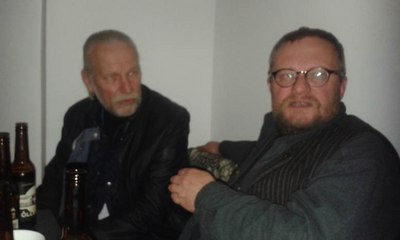 There were also late night parties at clubs close to the theatre. After the winners were announced at the closing ceremony the closing party was held at what was once a socialist social club and movie house. A complete list of all of the winning films is at the end of the article.
There were also late night parties at clubs close to the theatre. After the winners were announced at the closing ceremony the closing party was held at what was once a socialist social club and movie house. A complete list of all of the winning films is at the end of the article.
Animated Dreams has not had a permanent festival director for a few years but now that Mari-Liis Rebane has taken over the festival helm I think that it is now in good hands. Her programing was excellent this year with screenings that attracted local audiences. There was also a large group of friendly volunteers who were always handy to answer questions.
I can’t thank Mari-Liis Rebane enough for inviting me to be part of the festival and I look forward to future visits to Animated Dreams. If you are ever invited to the festival I urge you to attend because you will have a wonderful time seeing excellent animation in a beautiful city. You can read more about the festival at: www.anima.ee
JURY : Emma de Swaef (Belgium), Tsvika Oren (Israel) and Kalju Kivi (Estonia).
GRAND PRIX NAIL of Heino Pars presented by Eesti Nukufilm and Eesti Joonisfilm:
The Bigger Picture – Daisy Jacobs, United Kingdom
BEST STUDENT FILM presented by Animator Mentor:
About A Mother – Dina Velkovskaya, Russia
BEST SOUND DESIGN:
Fugue For Cello, Trumpet, and Landscape – Jerzy Kucia, Poland
BEST NON-NARRATIVE ANIMATION:
Five Minute Museum – Paul Bush, United Kingdom
JURY MEMBERS SPECIAL MENTIONS:
Special Mention by Kalju Kivi:
Beaches No. 0458 – Ivan Maximov, Russia
Special Mention by Emma de Swaef:
World of Tmorrow – Don Hertzfeldt, USA
Special Mention Tsvika Oren:
The Master- Riho Unt, Estonia
